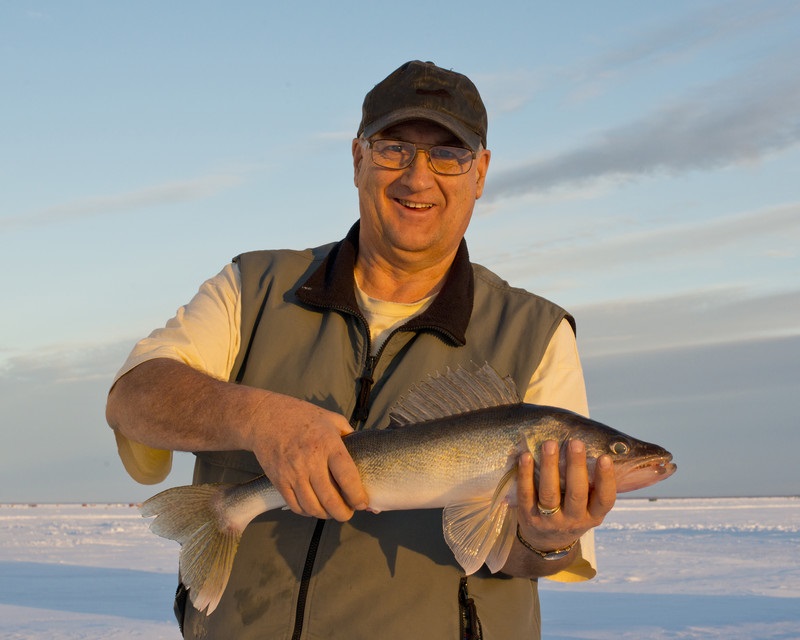Walleye Fishing written by: richardfred
You can find walleyes in very small natural walleye lakes less than 50 acres or large areas or entire lakes, such as the western basin of Lake Erie which incidentally covers over 1265 square miles. You can find them from the very clear deep lakes of Canada, to very cloudy silted shallow waters. They are equally comfortable in still or flowing water.
Natural lakes provide far more walleye habitat than any other type of water. North America natural lakes are home to the majority of the walleye’s population, when you look at percentage breakdown of the entire walleye habitat spectrum. Here’s a breakdown by percentage: 94% Natural walleye lakes, 5% man-made reservoirs, 1% rivers and streams.
As a result of widespread stocking outside their native range, walleyes are now found in 32 % of all the freshwater acreage in North America creating many pristine walleye fishing waters.
Populations are usually highest in large shallow walleye fishing lakes with moderate to low water clarity. For example, a large body of water, such as the western basin is likely to have many windswept shorelines and reefs that are excellent for walleye spawning grounds. And a shallow fishing lake is likely to provide more food then deep water walleye lakes. A lake needs to have shallow feeding shelves in order to have a good population of walleyes; if the shoreline drops sharply into deep water and these shelves are not present the population of walleye will be much smaller. Waters of low clarity limit the sunlight penetration and shield the walleye’s light sensitive eyes.
A Oligotrophic walleye fishing lake will have fair to good walleye populations. Lakes of this nature are usually cold and infertile, but have many rocky basins that make good spawning habitat.
As we said before, a Oligotrophic walleye lake will have fair to good walleye populations, and these lakes are usually cold and infertile, but have many rocky basins that make good spawning habitat. Walleyes in Oligotrophic deep lakes will live longer but will not grow as big or as fast as in shallower, low clarity warmer fertile lakes. Most Oligotropic lakes are in remote areas, so anglers take fewer walleyes.
Mesotrophic walleye fishing lakes generally have the largest population of walleyes. These moderately fertile lakes produce good food crop, so walleyes grow fairly fast. These lakes most likely have natural walleye spawning because there is enough gravel or rubble for a successful spawn. Mesotropical walleye lakes seldom have a winter kill but may lack oxygen at the deeper depths.
A Eutrophic walleye fishing lake will be highly fertile and have abundant food supplies. Eutrophic fishing lakes walleyes grow very rapidly. The problem with these lakes is there are no natural spawning grounds because of silted water deposits in the lake. Many times artificial spawning areas will be built in these lakes. Heavy stocking is often required to keep a good population of walleyes in these lakes. If a Eutrophic Walleye Lake is less than 25ft deep, a heavy snow cover for any length of time will cause multiple winter fish kills.
Other best locations for Walleye fishing include;
-Bay of Quinte
Few places on the planet have garnered just as much walleye admiration as the Bay of Quinte. Most observed because of its trophy potential in the wintertime and fall season, the bay also provides steady walleye fishing during the spring and summer. An excellent early season strategy involves jigging out before the Trent and Moira River. Fish stay in the bay all summer where about the most presentations involve casting stick baits overtop and along weed edges.
-St. Lawrence River
Walleye inhabit the complete 200 km stretch out of the St. Lawrence where it moves across the southeastern border of the province. The excellent pure water is a major part of the fisheries’ figure. The starting weeks of the growing season find walleye focused near spawning tributaries. Through the summer, many seafood drop out in to the deeper shipping route. Trolling profound diving crank baits or dragging heavy lower part bouncers is a favorite approach. When drinking water temperatures commence to drop in the land, seafood shall move less difficult shallow, where they can frequently be captured by fishermen doing some fishing from shoreline during the night.
-Ottawa River
Ask Yannick Loranger of Ottawa River Guided Angling where the best local walleye area is, and you will not be astonished by his answer. Yannick has generated a business across the flourishing walleye fishery of the Ottawa River. Trolling shallow-running spinners and crank baits over shallow vegetation can be a major winner, in the spring especially. Through the summer and fall, Yannick’s top presentation involves bottom bouncing worms on Slow Death hooks and worm harnesses along breaks and current seams in the key river.
-Niagara River
Regardless of being so near heavy inhabitant’s centers, the size and complexity of this area permit walleye populations to thrive. Denis Kreze owns a tackle store in Fort Erie and knows Niagara River walleye well. “The walleye angling on top of the Niagara River has been gradually getting better lately,” Denis confides. His top presentations include crawling a jig and minnow on underneath in spring and coil and casting or trolling big keep baits during the night through summer.
-Lake Erie
Lake Erie is definitely known as a significant walleye fishery, specifically for fishermen who prefer to troll the available drinking water. “Lake Erie walleye are no more simply for trollers,” says Denis Kreze, “It’s nothing nowadays to venture out and intentionally target walleye, when you can find areas positioning classes of yellowish perch especially.” A few of Denis’ best action comes when vertically jigging blade baits when the key lake is a little bit off-colored. “It’s amazing how much we continue steadily to find out about this fishery,” Denis expounds.
Big, intricate fisheries are ideal places to increase big walleye, and Southern Ontario has both these bases covered!

